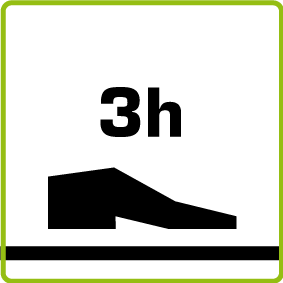2C R omnibind
Pre-treatment tile
Applications
Use as a stress-distributing membrane on (heated) working substrates with possible expected deformations such as shrinkage, creep and slight bending. Can be applied on fresh concrete and new cement screed floors that are only a few days old. Use as a substrate where a low mechanical load of the adhesive finish (such as natural stone tiling, cork and parquet) is required. The membrane bridges and fills cracks slightly and can be reinforced with embedded glass fibre fabric for applications where extreme stress loads such as vibrations can be expected. 2C R omnibind protects the subsoil against the infiltration of water with thaw salts, saltwater, sulphates and chlorides dissolved in it. Very strong vapour barrier and cannot be classified under vapour-permeable systems. However, the product is not gas-tight. It is a two-component low-flowing mortar when stirred and smeared: 2C R omnibind and FLEX+ omnibind, which gives an optically smooth finish after curing. Examples of applications include residential construction, commercial construction, public spaces, supermarkets, airports, roadside restaurants, shopping arcades, swimming pools, industrial spaces, platforms, moisture-intensive areas, balconies, terraces and gallery floors.





Getting started with 2C R omnibind
Certificates and documents
Download the documents available from this specific product here.
Can't find the right certificate?
Contact usVideos
Here you will find the videos available for this specific product. If you didn't find what you were looking for, check out our YouTube channel.
Let us help you out
Why should I apply a sealant?
Sealing materials are applied in places or spaces where one wants to prevent the effects of use from spreading to adjacent spaces, such as moisture in a bathroom.
Do I use a primer, a coat, or a decoupling mat for sealing?
This choice depends heavily on the situation and the application of your project. Is there a moist environment or are you working within the spray range? This, combined with a risk assessment, determines whether to choose a primer, a paste (coat?), or a complete system of decoupling mats, combined with special fittings.
Isn't a tile finish waterproof?
A finish in (ceramic) tiles should not be considered waterproof, due to factors such as the possibility of microcracks and at the location of the tile edges. Applying the correct waterproofing to the substrate before starting the tiling work is therefore essential.








